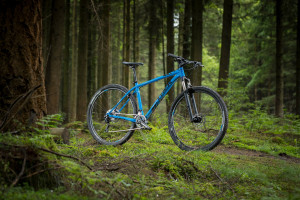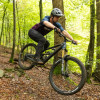The Ragley Big Al is a gravity-focussed alloy-framed hardtail that’s received a reasonable update for 2023. Now with revised angles, the brand has applied its years of hardtail experience to create a bike that comfortably pairs the all-out capability of a long and slack enduro full susser with the unpredictable thrill that can only be found on a rigid rear end. Ragley’s tweaks have resulted in an awesome bike that exhibits clear improvements and its build quality is stellar but just how good is it compared to other options in the best hardtail mountain bike space?
- Five reasons why you should have a hardtail
- Ragley Mmmbop 1.0 review
- 5 best upgrades for your new mountain or gravel bike
Ragley Big Al frameset - Technical details
With riders pushing their bikes harder and faster than ever, Ragley says that it's tweaked its recipe to suit. For the Big Al, the alloy framed counterpart to the steel Big Wig, that means a longer, slacker and lower geometry. A classic story.
By tweaking the Big Al’s geometry, Ragley has aimed to balance the capabilities required to cope with and accommodate more hardcore riding with a sensible, all-day riding character. Bearing that in mind, the bike gets a slack 63.5-degree head angle and a 75-degree seat tube angle. These figures have been chosen to offer more control when the trail steepens, and a more balanced riding position when pedalling.
The bottom bracket is five millimetres lower than before in a bid to add stability and, on this large frame, there’s a fairly lengthy 480mm reach. The chainstay is then mega-short at 435mm and the Big Al rolls on 29-inch hoops at either end. What’s also a big step forward is that the seat tube has had a chunk taken off, meaning that on a large, it measures 440mm.
A shorter seat tube is great for two reasons; it allows riders to install longer travel dropper posts to get the saddle well out of the way on the descents. It also offers the opportunity for customers to size up and take advantage of a longer reach without wrestling with a tall seat tube on the descents.
As for frame details, it’s all rather modern and has been picked for easy maintenance. Following that trend, there’s a threaded bottom bracket that’ll offer easy replacement when the time comes and there are ISCG05 tabs should you want to fit a chain guide. There’s internal cable routing for a tidy dropper post whereas each other cable is externally routed to offer simple brake fettling. The frame features 148x12mm rear wheel spacing and room for up to a 2.5in tyre. As a hardtail, it would be great to see accommodation for fatter rubber for more bump absorption.
Ragley has chosen to build the Big Al using 6061 alloy tubing for its durability but also its compliance and comfort. As for forks, this frame is designed to work with 150 up to 160mm travelled units. For our test, we were given a 160mm fork.
For 2023, the brand is offering its latest models as framesets only. However, they’re offered alongside its 2022 range, so full bikes are still available but without the fresh geometry tweaks.
Ragley Big Al frameset - Performance
Before getting into how this bike rides, it is worth touching on its aesthetics. The Aqua/Black colourway pops and its new geometric figures give the big a much more aggressive look even when standing still. Around the frame are little trinkets and Ragley logos which transform a relatively inexpensive frame with a more high-end look.
Throwing a leg over the bike for the first time, I was greeted with the very same ‘Ragley’ feel that I've come to know and appreciate. But on the latest Big Al, things are a bit different and totally in line with the changes that have been made.
Notably, the bike feels longer and slacker which is definitely a good thing and expected for a bike of this gravity intention. The new changes, notably the longer reach has resulted in an incredibly spacious cockpit, which will be greatly appreciated by riders with taller torsos. Over flat ground, this poses no issue and was surprisingly comfortable, though when pedaling uphill, I noticed that this limited my ability to shift my weight around over the bike.
For the most part, there was no serious issue with this. It was more a comfort thing but with Ragley’s decision to stretch the reach figure so considerably (by 20mm from 460mm), the seat tube angle could have been steepened by more than the meagre degree that the new frame has received. That’s the case with many other bikes with similar reach measurements.
Doing so would effectively shrink the cockpit and make for a bike that’s a bit more comfortable to pedal nearly everywhere. Though with Ragley’s somewhat ‘do-it-all’ intentions, I can understand the conservative approach as having some weight behind the bottom bracket is useful as it helps drive the bike through chunky flat sections.
The bike’s behaviour when climbing is sensible and welcoming - everything you would expect from a hardtail. It’s efficient and noticeably stiff from those alloy tubes but lengthy shleps up a hill were tackled almost effortlessly. And to my surprise, both wheels remained mostly planted with the front wheel only lightening during the steepest sections.
On the downs is where the Big Al’s massively capable but all-over playful character comes out to play. It’s a bike that’s reassuringly confident to the point where its lack of rear suspension is all too easy to overlook, which can get the rider into some rather serious trouble. Albeit, as they whoop and holler down the trial. This is also where Ragley’s geometry fettling makes the most sense.
The geometry figures on this frame look more natural on a purpose-built enduro rig and that’s the jewel in the Big Al’s crown as it can be ridden with a similar level of wreckless abandon until the rear wheel skips out around a switchback, reminding the rider that there’s nothing but the tyre’s volume for rear suspension. Of course, as a hardtail it isn’t as effective when pulling on the anchors which forces the rider to commit to whatever hooliganism they’re about to throw themselves down but - because of the frame’s length and the support summoned by the slack head angle - it’s more than accommodating when it comes to devouring descents.
Even though it’s what the Big Al is built to do, I was surprised by how possible it made steep descents. As mentioned before, the bike’s new lengthy front centre makes it as sure-footed as a hardtail can get, leaving just the rear end for a bit of management when needs be.
Geometry affecting fork dive is a factor that needs to be considered however. I usually prefer my hardtails with less fork travel to combat this but during heavier compressions, the amount the fork moves through its travel effectively steepens the bike’s head angle. While the long reach does combat this to a degree, it takes a conscious effort not to be spat over the front of the bike. But importantly, when hitting steep sections into catch berms, the bike’s confident nature wains as its geometry shifts so much. This is just how long travel hardtails work, however.
The Big Al is no slouch on flatter and flowier trails, which is a clear hint towards its versatility. It does require a bit of an adjustment in riding style as weighting the front a little more rewards with more grip but its short chainstay adds a whippable character when navigating tight corners. But there’s a clear sense of stability that comes as a result of the lower BB and again, that length. This makes the bike almost too comfortable to ride at speed, which is ideal for a gravity and enduro focussed frame.
In all situations, the frame is one that utilises its 29-inch wheels incredibly well and, actually, as if it hasn’t been fought over enough already, is a fantastic argument for the big wheel. Because it's so encouraging of aggressive riding, the large hoops help take the sting out of successively lumpy sections, thus improving control basically anywhere. They also help gather momentum and hold it.
Ragley Big Al frameset - Verdict
The £350 asking price for an alloy frame of this quality shows rather good value. You’re getting a capable but fun frame that carries a hint of luxury, thanks to stamped logos and its stunning paint job.
To compare, Marin’s San Quentin is an equally as aggressively shaped frame but it gets a slightly steeper head angle and 650b hoops. Though notably, its seat tube is steeper at 77 degrees, which should make climbing more comfortable. That’s priced at £435
Commencal’s £400 Meta HT AM is more conservative with a shorter 450mm reach measurement, a slacker 74.5-degree seat tube angle, and a steeper 64.5 degree head angle. It does get full internal cable routing though, if that’s your thing.
A favourite of mine and a close competitor in terms of performance is the Stif Squatch. This improves upon the Big Al with a steeper seat tube and space for fatter rubber, and it's available in full builds. However, its steel frame makes it almost double the price at £650.
Whether you’re looking to race without rear suspension or if it’s gravity focussed ridiculousness that you’re looking for, the Ragley Big Al is worth a gander. It’s impressively capable and confident even down the silliest of tracks and, due to the fact it's a hardtail, it’s massive fun. The frame’s build quality and paint job are a lovely bonus, too. However, a steeper seat tube would improve the overall ride and room for bigger tyres would be nice. Though mostly, it’s a huge shame that it’s not available as a full build for those who simply want to grip and rip.



















Add comment